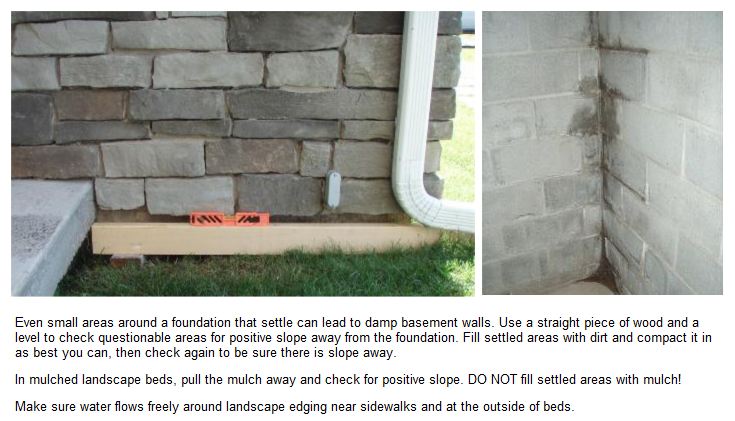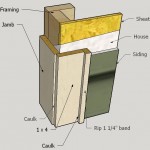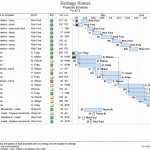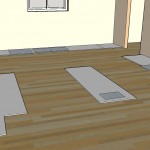Performance Standard: HBR articles 1-3 to 1-5 Click icon to view book 
Seed washout or germination
Warranty period: NONE
Tree damage (pre-existing)
Warranty period: NONE
Performance Standard – NONE
Heritage Homes installs a “starter lawn” (see Grading & Drainage) and landscaping plantings according to contract specifications.
Notes
Providing complete details on landscape design is beyond the scope of this manual. Plan to install the basic components of your landscaping as soon after closing as weather permits. In addition to meeting any homeowner association requirements to landscape in a timely manner, well-designed landscaping prevents erosion and protects the foundation of your home.
Homeowner Operation and Maintenance
Backfill – (see also Grading & Drainage)
We construct the foundation of your home beginning with an excavation into the earth. When the foundation walls are complete, the area surrounding the foundation is backfilled. Soil in this area is not as compact as undisturbed ground. Water can penetrate through the backfill area to the lower areas of your foundation. This can cause potentially severe problems such as wet basements or cracks in the foundation walls. Avoid this through proper installation of landscaping and good maintenance of drainage.
Backfill areas will settle and require prompt attention to avoid damage to your home and voiding of the structural warranty.
Keep downspout extensions in the down position to channel roof runoff away from the foundation area of your home. Routine inspection of downspouts, backfill areas, and other drainage components is an excellent maintenance habit.
Bark or Rock Beds – Do not allow edging around decorative rock or bark beds to dam the free flow of water away from the home. This can lead to wet or damp basement walls and voiding of the structural warranty.
You can use a non-woven landscape fabric between the soil and rock or bark to restrict weed growth while still permitting normal evaporation of ground moisture.
Erosion – Until your yard is established and stable, erosion will be a potential concern. Heavy rains or roof runoff can erode soil. The sooner you restore the grade to its original condition, the less damage will occur.
Erosion is of special concern in drainage swales. If swales become filled with soil runoff, they may not drain the rest of the yard, causing further problems. Correcting erosion is your responsibility. You may need to protect newly planted seed with erosion matting or reseed to establish grass in swales. It can take several years to fully establish your lawn in such challenging areas.
Hired Contractors – You are responsible for changes to the drainage pattern made by any landscape, concrete, deck, or pool contractor. Discuss drainage with any company you hire to do an installation in your yard. Do not permit them to tie into existing drainage pipes without approval.
Natural Areas – During construction, we remove only construction debris from natural, undisturbed areas. Removing dead wood, tree limbs, fallen trees, or other natural items is your responsibility.
Plant Selection – Plant with regard to our winter climate. Favor native over exotic species. Consider ultimate size, shape, and growth of the species.
Requirements – Check with your local building department and homeowners association before designing, installing, or changing landscaping for any regulations that they require you to follow.
Seeded Lawns – Heavy storms can cause washouts and erosion that you will need to correct. It generally takes at least three growing seasons to establish a good sod, longer if weather conditions are difficult or if you do not have the time to devote to lawn care.
Before over-seeding, remember to fill any slight depressions with a light layer of topsoil. Minimize traffic of all kinds on newly seeded areas and avoid weed killer for at least 120 days. Keep the seed moist, not wet.
Stones – The soil in your area will have stones and rocks. Removing these naturally occurring elements is a maintenance activity. If BUILDER installs seed or sod, large rocks will be picked up as surface raking is performed. You will need to provide continued attention to this condition as you care for your yard.
Trees – BUILDER values trees as one of the features that make up an attractive community and add value to the homes we build. We take steps to protect and preserve existing trees. In spite of our efforts, existing trees located on construction sites can suffer damage from construction activities, which manifest months after the completion of construction.
Damage to existing trees can be caused by such things as compaction of soil in the root zone, changing patterns of water flow on the lot, disturbing the root system, and removing other trees to make room for the home. The newly exposed tree may react to conditions it is unaccustomed to. Caring for existing trees, including pruning dead branches or removing these trees altogether is your responsibility.
Trees and other plant materials that exist on the lot when construction begins and are not part of any landscaping installed by BUILDER are excluded from warranty coverage.
Weeds – Weeds will appear in your new lawn. When soil is disturbed, dormant seeds come to the surface and germinate. The best control is a healthy lawn, achieved through a regular weed and feed program. Follow manufacturer’s recommendations.
Lawn Care Calendar
May
- Control lawn weeds
- Fertilize turf late this month
June-July
- Monitor for Sod Webworms and Chinch Bugs, control if necessary
- Water as needed
August
- Check for Grubs, if more than 5-8 per square foot, apply Grub control, water it in
Late August – Mid September
- Seed whole lawns or fill bare spots, ryegrass blends can be seeded until early October
September
- Thatch turf
Late November (Thanksgiving)
- Apply winterizing fertilizer, high in fast release Nitrogen and Potash
Greener Living Tips
Notes
Lawns do more than make your yard look good. Lawns absorb water, which helps reduce storm runoff and improve water quality. Lawns also have a significant cooling effect, provide oxygen, trap dust and dirt, promote healthful micro-organisms, prevent erosion and filter rainwater contaminants.
The only way to reduce a dependence on chemical fertilizers is to develop a healthy lawn, which is naturally resistant to weeds, insects and diseases. If you need to fertilize your lawn more than once a year, consider these ways of improving the natural health of your lawn:
Improve the Soil – The first step is to test the soil’s pH – it should read between 6.5 and 7.0, which is slightly acidic. Soil that is too acidic will need a sprinkling of lime; sulfur can be added to soil which is not acidic enough. Call your county cooperative extension office – they often provide soil testing as a free service.
Lawns grow best in loamy soils that have a mix of clay, silt and sand. Too much clay in the soil mix, or heavy use, can compact the soil and prevent air and nutrient flow. Compacted soil may need aeration, a process of lifting small plugs of turf to create air spaces in the soil. For best results, rent an aerator or hire a lawn service to do the job – this will remove “finger size” plugs which improves aeration. Aeration is best done before top dressing and fertilizing.
Organic matter, such as compost and grass clippings, will benefit any type of soil; it lightens soil which is heavy in clay, and it builds humus in sandy soils, which helps retain water and nutrients.
Mow Often, but Not Too Short – Giving your lawn a “Marine cut” is not doing it a favor. Surface roots become exposed, the soil dries out faster and surface aeration is reduced. As a general rule, don’t cut off more than one-third of the grass at any one time. Most turf grass species are healthiest when kept between 2.5 and 3.5″ tall
Water Deeply but Not Too Often – Thorough watering encourages your lawn to develop deep root systems which make the lawn hardier and more drought-resistant. Let the lawn dry out before re-watering; as a rule of thumb, the color should dull and footprints should stay compressed for more than a few seconds. When watering, put a cup in the sprinkler zone; it should get at least one inch of water.
The best time for watering is early morning – less water will be lost to evaporation. Ideally, it’s better to water the first half-inch or so, and then wait for an hour or two before watering the second half-inch.
Watering needs for different grass types – How long can you wait between waterings before the lawn starts to go brown?
8 – 12 days: Carpet grass, Fine fescue, Kikuyu grass, Seashore paspalum, Tall fescue
5 – 7 days: Ryegrass, Kentucky bluegrass, Bentgrass
The fine-leaved fescues (grass blades) as well as the “common” types of Kentucky bluegrasses, such as Park and Kenblue, require less water, fertilizer and cutting than turf-type perennial ryegrass or many of the newer “improved” types of Kentucky bluegrass.
Source: University of Georgia, College of Agricultural and Environmental Sciences
Leave clippings on the lawn – This provides nutrients equivalent to one application of fertilizer. Clippings do not cause thatch.
Fertilize once or twice a year – This is sufficient for an attractive lawn. Cool season grasses are semi-dormant in the summer; fertilizing during summer will be ineffective. Fertilizing in early fall promotes vigorous lawn growth the next spring.
Use a fertilizer with time-released, water insoluble nitrogen – These fertilizers are less likely to burn your lawn with excess nitrogen, and slow-release allows the roots to absorb the nutrients as needed. In most instances, choose fertilizers containing at least 35% – 50% of their nitrogen supply in the “slow-release” form, such as sulfur-coated urea, methylene urea or various natural organic products. With fast-acting fertilizers, some nutrients are washed away with watering or rain, and the wasted fertilizer pollutes ground water supplies.
Control lawn weeds with corn gluten – A nontoxic byproduct of corn processing, corn gluten kills weed seedlings within days of application. It also adds nitrogen to your soil. Just one application, before weeds emerge, reduced weed survival by 60%, according to research at Iowa State University. After several years, this method provides as much as 90% weed control.
Keep pesticide/herbicide use to a minimum – Pesticides kill the soil organisms which contribute to a healthy lawn. The sooner you remove harsh chemicals, the faster your soil will recover. Repeated past use of toxic chemicals may have destroyed the micro biotic life that exists in healthy soil; it will take time, at least a season, for the soil to begin to recover. If lawn chemicals are used, clean out applicators and empty containers on the lawn where the residue will be utilized. Do not clean them out on sidewalks or driveways, or residue will go directly into water supplies.
‘Spot-treat’ weeds with vinegar to minimize herbicide use – Where only a few scattered broadleaf weeds such as dandelions or plantain are present, consider spot-treating individual weeds with household vinegar rather than applying a broadcast treatment of an herbicide over the entire lawn. (Vinegar can burn grass and garden plants, so be sure to spot treat weeds only.) Physically pulling or cutting weeds is also effective; remove as much of the root system as possible to reduce the chance of re-growth.
Lawn grubs – For lawn grubs, there is a natural remedy called milky spore . The granules are spread on the soil and cause the grubs to contract a disease that kills them. Only the grubs are affected, leaving beneficial organisms unharmed. Milky spore multiplies over time and will sit inactive, waiting for grubs to infect. One treatment is said to last 40 years. The grubs are actually the larvae of Japanese beetles. So, when you kill the grubs you kill the beetle.
Hand raking – If the clippings are too long and must be raked, try hand raking. This light aerobic exercise will save you a trip to the gym. Fallen leaves make excellent mulch for flower or garden beds, or can be added to your compost pile where they’ll be converted to rich, organic humus for the garden.
BUILDER Limited Warranty
Seed – BUILDER is not responsible for seed germination or washout of any amount.
Landscape plants we install are warranted for the growing season in which they are planted. We will confirm that all plants are alive during the final walk through or shortly after planting whichever comes last.
BUILDER is not responsible for plants that do not survive over winter.
Broken, cracked or flaking sidewalk and/or patio slabs are not warranted.
Maintaining landscaping, including established grades, is your responsibility.












